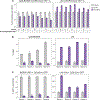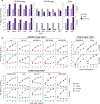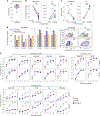Host cell glycosylation selects for infection with CCR5- versus CXCR4-tropic HIV-1
- PMID: 39363105
- PMCID: PMC12335854
- DOI: 10.1038/s41564-024-01806-7
Host cell glycosylation selects for infection with CCR5- versus CXCR4-tropic HIV-1
Abstract
Human immunodeficiency virus type 1 (HIV-1) infection involves a selection bottleneck that leads to transmission of one or a few variants. C-C motif chemokine receptor 5 (CCR5) or C-X-C motif chemokine receptor 4 (CXCR4) can act as coreceptors for HIV-1 viral entry. However, initial infection mostly occurs via CCR5, despite abundant expression of CXCR4 on target cells. The host factors that influence HIV-1 susceptibility and selection during transmission are unclear. Here we conduct CRISPR-Cas9 screens and identify SLC35A2 (a transporter of UDP-galactose expressed in target cells in blood and mucosa) as a potent and specific CXCR4-tropic restriction factor in primary target CD4+ T cells. SLC35A2 inactivation, which resulted in truncated glycans, not only increased CXCR4-tropic infection levels but also decreased those of CCR5-tropic strains consistently. Single-cycle infections demonstrated that the effect is cell-intrinsic. These data support a role for a host protein that influences glycan structure in regulating HIV-1 infection. Host cell glycosylation may, therefore, affect HIV-1 selection during transmission in vivo.
© 2024. The Author(s), under exclusive licence to Springer Nature Limited.
Conflict of interest statement
COMPETING INTERESTS
The authors declare no competing interests.
Figures








Update of
-
Host cell glycosylation selects for infection with CCR5- versus CXCR4-tropic HIV-1.bioRxiv [Preprint]. 2023 Sep 5:2023.09.05.556399. doi: 10.1101/2023.09.05.556399. bioRxiv. 2023. Update in: Nat Microbiol. 2024 Nov;9(11):2985-2996. doi: 10.1038/s41564-024-01806-7. PMID: 37732222 Free PMC article. Updated. Preprint.
References
MeSH terms
Substances
Grants and funding
- F31AI165168/U.S. Department of Health & Human Services | NIH | National Institute of Allergy and Infectious Diseases (NIAID)
- R01HD103571/U.S. Department of Health & Human Services | NIH | Eunice Kennedy Shriver National Institute of Child Health and Human Development (NICHD)
- T32 GM007270/GM/NIGMS NIH HHS/United States
- F31 AI165168/AI/NIAID NIH HHS/United States
- R01 HD103571/HD/NICHD NIH HHS/United States
LinkOut - more resources
Full Text Sources
Medical
Research Materials

